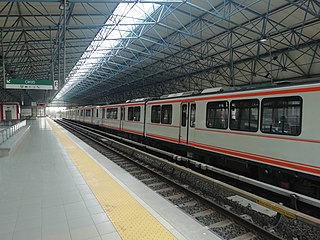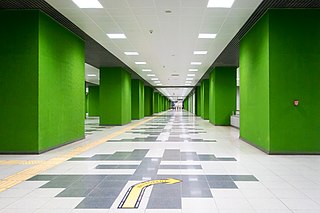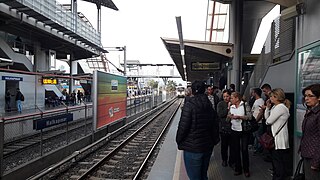
The Ankara Metro is the rapid transit system serving Ankara, the capital of Turkey. At present, Ankara's rapid transit system consists of two metro lines – the Batıkent Metrosu (M1) and the new Keçiören Metrosu (M4) line opened in 2017, along with the Ankaray line. The Ankaray, the M1 and M4 lines, together transported 104.1 million passengers in 2014. That corresponds to a ridership of approximately 289,155 per day. In February 2019 all the lines that used to run M1, M2 and M3 were merged to create one line, M1.

The Istanbul Metro is a rapid transit railway network that serves the city of Istanbul, Turkey. Apart from the M11 line, which is operated by TCDD Taşımacılık, the system is operated by Metro Istanbul, a public enterprise controlled by the Istanbul Metropolitan Municipality. The oldest section of the metro is the M1 line, which opened in 1989. As of 2024, the system now includes 159 stations in service, with 36 more under construction. With 243.3 kilometers, Istanbul has the 21st longest metro line in the world and the 5th in Europe.

Ankaray, designated as the A1, is a 8.5 km (5.3 mi) long rapid transit line of the Ankara Metro system in Ankara, Turkey. Opened in 1996, it is the oldest rapid transit line in Ankara and the second oldest in Turkey after the M1 line of the Istanbul Metro. Ankaray begins at the Ankara Intercity Bus Terminal in southeastern Yenimahalle and runs east to Dikimevi in northeastern Çankaya and consists of 11 stations. In 2017, the line saw over 33.5 million boardings, making it the second busiest line of Ankara Metro, after the M1. Despite being a rapid transit line, the city of Ankara classifies Ankaray as a light-rail line.

Üçyol is an underground station on the M1 Line of the İzmir Metro in Konak. Located beneath İnönü Avenue, just west of Üçyol Square, it is one of the ten original stations of the metro system, opened on 22 May 2000. From 2000 to the 2012, Üçyol was the western terminus of the line. On 29 December 2012, the line was extended two stations westward to Hatay.

Mahmutbey is an underground station on the M3 and M7 lines of the Istanbul Metro in Bağcılar, Istanbul. The station is located beneath Bosna Avenue in the Göztepe neighborhood of Bağcılar. Mahmutbey was opened on 14 June 2013 along with the Kirazlı-MetroKent portion of the M3.

The Halkapınar—Otogar Line is a planned urban commuter railway line in İzmir, Turkey. The line has a total length of 4.5 km (2.8 mi) and would begin at Halkapınar Transfer Center and run southeast along Kamil Tunca Boulevard to the İzmir Bus Terminal. Construction of the line was approved in May 2017, and is expected to begin in December 2017 or January 2018. It was previously planned as a subway but revised in 2018 to be constructed as a commuter railway.

AŞTİ is an underground station and the western terminus of the Ankaray line of the Ankara Metro in Çankaya. It is located on the east side of Mevlana Boulevard, across from the Ankara Intercity Bus Terminal (AŞTİ). AŞTİ station consists of two side platforms and opened on 30 August 1996, together with the Ankaray line. Connection to the bus terminal is available via a passageway underneath Mevlana Boulevard.

Dikimevi is an underground station and the eastern terminus of the Ankaray line of the Ankara Metro in Çankaya. It is located under Cemal Gürsel Avenue in Cebeci, three blocks south of Cebeci station. Dikimevi station consists of two side platforms and opened on 30 August 1996, together with the Ankaray line. The line was originally planned to be extended further east in Mamak, however these plans never took place.

15 Temmuz Kızılay Millî İrade, formerly known and still commonly referred to as just Kızılay, is an underground station and a hub of the Ankara Metro. A total of four lines meet at Kızılay; Ankaray, the M1, the M2, and the M4. The station was first opened on 30 August 1996 with the Ankaray platform, while the M1 platform was opened on 29 December 1997.

Koru is an underground rapid transit station and the western terminus of the M2 line of the Ankara Metro. It is also the southwest terminus of the 46.6 km (29.0 mi) long continuous metro line, consisting of the M1, M2 and M3 lines. The station is located along Ankaralılar Avenue within Ahmet Taner Kışlalı Park and was opened on 13 March 2014. Connections to EGO Bus service is available on Şeyh Mucibur Rahman Boulevard. This station is secondary depot station in Ankara Metro(main depot station located at Macunköy station). Trains are added to and removed from the system from this station. The addition/removal process is done with a railway switch that connects to the mainline from the yard lines close to the station.
OSB-Törekent is an underground rapid transit station and the western terminus of the M3 line of the Ankara Metro. It is also the northwest terminus of the 46.6 km (29.0 mi) long continuous metro line, consisting of the M1, M2 and M3 lines. The station is located along Ahmet Andiçen Avenue and was opened on 12 February 2014.

Atatürk Kültür Merkezi is an underground station of the Ankara Metro in Altındağ, Ankara. It is a stop on the M1 line as well as the former southern terminus of the M4 line. The station is located along Istanbul Avenue at the intersection with Kazım Karabekir Avenue. Connection to EGO Bus service is available on Istanbul Avenue. The M1 station was opened on 29 December 1997, while the M4 station opened 19 years later on 5 January 2017.

Sıhhiye is an underground station on the M1 line of the Ankara Metro in Çankaya, Ankara. The station is located beneath Atatürk Boulevard at its intersection with Celal Bayar Boulevard. Connection to TCDD Taşımacılık train service at Yenişehir is available. Sıhhiye was opened on 29 December 1997 along with the M1 line.

Ulus is an underground station on the M1 line of the Ankara Metro in Altındağ, Ankara. The station is located beneath Istanbul Avenue at its intersection with Cumhuriyet Avenue. Ulus was opened on 29 December 1997 along with the M1 line. Ulus is located within the historic center of Ankara, with many historic government buildings in the vicinity.

Batı Merkez, is a surface rapid transit station of the Ankara Metro. Currently, only one line is in operation at this station. The station was opened on 12 February 2014, the same day the M3 line opened.

Mesa, is an underground rapid transit station of the Ankara Metro. Currently, only one line is in operation at this station. The station was opened on 12 February 2014, the same day that the M3 line opened.

Botanik, is an underground rapid transit station of the Ankara Metro. Currently, only one line is in operation at this station. The station was opened on 12 February 2014, the same day that the M3 line opened.

Macunköy, is a surface rapid transit station of the Ankara Metro. Currently, only one line is in operation at this station. The station was opened on 29 December 1997, the same day that the M1 line opened. This station is the main depot station in Ankara Metro. Trains are added to and removed from the system from this station. The 3rd rail is located in the middle of the station is used to store the backup train or the removal process of the trains. The addition process is done with a railway switch that connects to the mainline from the 4th line close to the station.

Şehitler is an underground rapid transit station of the Ankara Metro. The station was opened on 5 January 2017, the same day the M4 line opened which is also one of the terminus stations of the line.
Rapid transit in Turkey refers to the extensive network of urban rail systems serving major cities throughout the country. These systems play a crucial role in facilitating efficient and sustainable transportation, alleviating traffic congestion, and enhancing connectivity within urban areas. The rapid transit networks in Turkey consist primarily of metro, light rail, and tram systems, with ongoing expansions and developments aimed at meeting the growing transportation needs of its urban population.


















